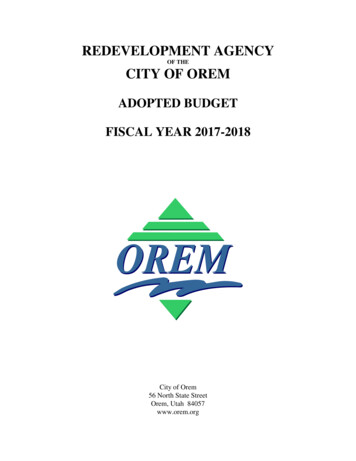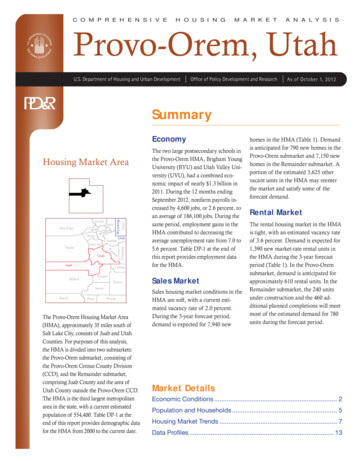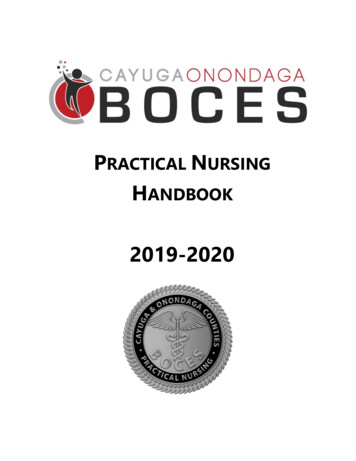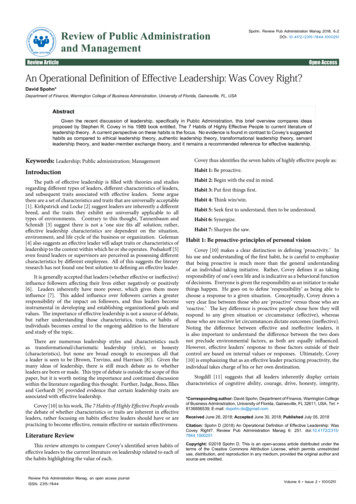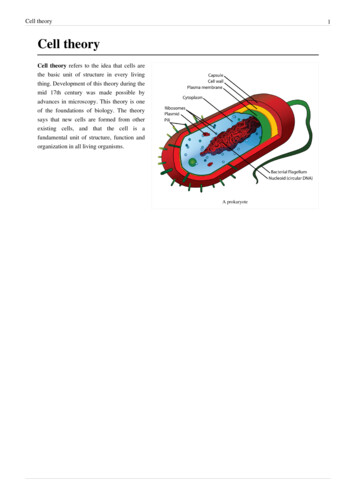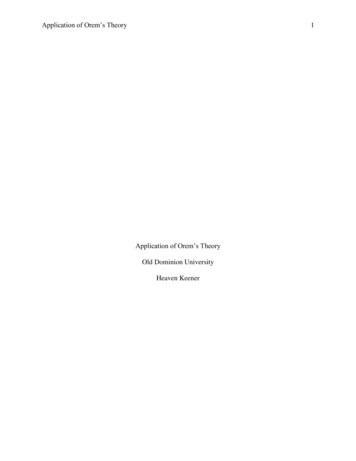
Transcription
Application of Orem’s Theory1Application of Orem’s TheoryOld Dominion UniversityHeaven Keener
Application of Orem’s Theory2Dorothea OremDorothea Orem’s Theory of Self-Care Deficit is a widely used nursing theory. Thepurpose of Orem’s theory is to identify deficits in a person’s self-care and improve or eliminatethe deficit. Bringing the person back to their own baseline or above the original baseline. Thetheory is divided into different sub-categories. Self-care, Self-care Deficit, and the NursingSystem are all sub-theories that create the main theory. Each sub-theory contributes to the wellbeing of the patient.The self-care theory is simple, it’s how patient can care for themselves. There are selfcare requisites that come together as a whole to make a compensatory person. Universalrequisites are what all people need to survive. Food, water, elimination, rest, and interaction justto name a few. A universal deficit has to potential to be a critical health issue. Developmentalrequisites vary by each person. Age, maturity, education, and gender are all factors.Developmental deficits are important to recognize for educational purposes. Health deviationrequisites are a defect that is a part of the person’s normal baseline. A health deviation could beconsidered an amputation or mental retardation. These factors are all necessary for a person toprovide adequate self-care.A self-care deficit can occur in any of the factors of the self-care theory. A self-caredeficit is a phenomenon that creates an imbalance of a person’s well-being. These deficits can beacute or long term. Any incident that decreases a person’s baseline and impedes their ability tocare for themselves has experienced a self-care deficit. For example, a person who has had a legamputation is now experiencing a deficit. Being able to participate in everyday life is no longereasy. Providing care for this patient would bring the patient back to a functional baseline, butnever a physical baseline. So having a deficit may be an ongoing occurrence.
Application of Orem’s Theory3The Nursing System is the most important part of this theory. Promoting self-care is adistinct part of being a nurse. Nurses must identify deficits, plan, educate, and implementinterventions to help patient’s return to their highest level of functioning. There are differentcategories of nursing care in this theory; Wholly compensatory, Partly Compensatory, andSupportive development. Wholly compensatory means the nurse is responsible for all patientcare. This can be acute or long-term. Examples of wholly compensatory people would be postoperative or intubated patients. Partially compensatory means that the person is able to completesome self-care activities themselves and other’s with the help of the nurse. Supportivedevelopment means that the person has encountered an event were the nurse must educate them.An example of this would a patient who needs to take enoxaparin shots at home. The patient maynot have a self-care deficit, but has encountered a change in which there is an added routine.This theory is beneficial to every kind of nursing care. The simplicity of it makes it easyto apply in practice as a nurse. The theory’s sole purpose is to benefit the patient. Nurses learnearly on in their career that self-care is necessary for a patient to function properly outside ofhealth care. There are no limitation in this theory. There may be some cases where the patientcannot fully obtain independence in care back. For example, a patient who has had a severeCerebrovascular accident may never be able to regain full language function back, leading tosocial and emotional deficits. The nurse would then reevaluate and intervene with activities toimprove the patient’s speech or a way to increase communication. Then the theory would beapplicable again to the patient. Orem’s theory works like a cycle, people will fall in and out ofneed for it throughout life.Articles of Application
Application of Orem’s Theory4Using the Teach-Back and Orem’s Self-Care Deficit Nursing theory to IncreaseChildhood Immunization Communication among Low-Income Mothers is a study that, directlyuses Orem’s theory. This study tested the correlation between literacy and a mother’s ability tocomprehend vaccination information. Writing, reading, and verbal understanding are key pointsof self-care. Mothers must have the ability to care for themselves and their children. Maternalliteracy provides proper judgment and decision making about health care for their children.Vaccinations are viewed as “protection from hazard”. National immunization rates are 75%,comparted to 60% in the low-income urban areas. (Baker, Legwand, Nordstrom, and Wilson,2008) These low-income urban areas are where maternal literacy rates are lowest. All patientsare provided with information on vaccinations but it is never clear if the patients understand it ornot.This study uses the Qualative-Quantative research design. They choose their sample froma walk-in child immunization clinic. 30 women were chosen, 15 having one child and 15 havingmore than one child. The age range was 18-47 and 60% had a high school education. 80% ofthese women were on Medicaid benefits and 20% were without health coverage. (Baker et al.,2008) Demographic and REALM (literacy test) data was collected from each participant.Information on the polio and pneumonia vaccinations were given to each participant followingthe CDC guidelines. The name, benefits, risk factors, and safety issues were discussed with eachmother. The participants were then asked to name at least three items from each topic. Beingscored by a points system, correct 1, partially correct 0.5, and incorrect 0. The results displayedthat literacy was the main factor to understanding vaccine information.This study applied Orem’s theory correctly. Children rely on the competency of theirparents for proper health care. This study evaluated how the literacy rate affected a mother’s
Application of Orem’s Theory5choice in vaccinating her child. Without proper understanding of the vaccine, the mother willchoose against vaccinating her child. The issues with this study is the small sample size. Thesample size makes reliable results limited. The place that the participants were chosen somewhatlimits the results. Choosing women who only went to the immunization clinic only provides datafrom women who obviously want to vaccinate their children. Despite their ability to understandthe data, the women were most likely going to vaccinate their child anyway.Challenging RN-BSN Students to Apply Orem’s Theory to Practice is an article aboutapplying Orem’s theory in the education system. There is a great push for Bachelor degreeeducated nurses whether it be job related or a personal goal. A traditional BSN program provideseducation of nursing theory where as an Associates program does not. This school based its RNBSN program on Orem’s theory. All nine classes included the theory but only one class, NursingIssues, is reviewed in the article. Nursing issues allowed its students to apply the theory to theircurrent practice.The class enrolled 30-50 students per semester in a seven week semester. The class waspresented online, with three online meetings. The class was composed of Discussion posts,department in-services, a formal paper, PowerPoint presentation, and group work. Each groupwas given a different topic that related to Orem’s theory. The groups are communication,transformative teaching, leadership, ethical practice, legal practice, cultural sensitivity, andprofessional behavior. The major assignment for the class is given a topic that is a current issuesin nursing, the topic varied each semester. Past topics included Magnet Status, Nurse to Patientstaff ratio, and use of CEUs. Each group related the topic to their assigned title and used Orem’stheory as the base to research. This helped the students gain a better understanding of using
Application of Orem’s Theory6nursing theory. One student stated, “I have a better perspective of what nursing is after learningto apply Orem’s theory to my practice.” (Davidson, 2012 )This article did not directly test Orem’s theory. Instead it showed how the theory can be auniversal education tool. The theory is easily applied to everyday practice and makes since to thepracticing nurse. Which made it an appropriate basis for the RN-BSN program. The only flaw inthe program is that the student’s should be introduced to many different nursing theories.Clinical Practice IssuesAmbulatory surgery can directly relate to Orem’s theory. Patient’s come in either in goodhealth or physical deficits and leave with improved health but a short-term self-care deficit.There are many issues that can occur in this setting. Education is a major part of surgicalservices. Discharges are done with patients or family who are typically stressed at the time ofreview. Discharges are fast and the recipient may not absorb all of the information given.Discharge information also varies upon specialties and among surgeons. For example, onesurgeon allows his knee arthroscopy’s to shower and the other doesn’t. Also, the way theincision is cleaned and dressed varies among all three orthopedic surgeons. This sometimes leadsto some confusion when filling out discharge papers because there is no “standard”. The followup phone calls we place cover pain, nausea, vomiting, and how they thought their care was. Wedischarge several different kinds of patients each day with self-care impairment and never askthe question “How are you caring for yourself?” These are practice issues that are seen in theAmbulatory care unit.Orem’s theory works well in a surgical department. The theory can be used at the time ofdischarge by providing the patient with better education of their do’s and don’ts. Providing thepatient with the physician’s and the unit’s phone numbers can increase the likelihood that the
Application of Orem’s Theory7patient will call when they have questions. Prescreening patients so you know they have others tohelp them would be helpful before discharge. The follow up calls can have added detail such as,how are caring for yourself, do you have someone to help you, and how is the healing processgoing. Orem’s theory has many ways that it can be applied to the Surgical Unit.Personal PhilosophyMy personal philosophy of nursing incorporates a lot of education. Education is a keytool for nurses to provide the best for their patients. Orem’s theory is based on education andproviding the patient with diligent care. Personally, seeing a patient grow and come back to theirown baseline is the most rewarding part of being a nurse. Orem basis her theory on identifyingwhat a patient lacks in self-care and providing the patient with interventions that return them tonormalcy. I have enjoyed Orem’s theory and am able to apply it in my everyday practice.LearningThis assignment contributed to my knowledge of Orem’s theory. Having to read in to thetheory makes it more complicated to understand, yet I learned a lot about it. In general, I havelearned that nursing theory is a basis to all of nursing practice. Everything we do today is basedoff of some sort of nursing theory. Nursing education is now even based off of theory. I am ableto go to work now and see my patient as a whole. I am starting to put a bigger picture togetherthan I could before. I am convinced that it is all because of the Bachelor program.This theory applies to my practice in many ways. This is where I am seeing myeducational experience improve my work experience. Self-care deficits are what health care ismade of. Every sick person that walks into a hospital, urgent care, surgery center, or doctor’soffice is experiencing some sort of self-care deficit. Orem’s theory is universal. If we werewithout health-care deficits, we would have no need for health care.
Application of Orem’s Theory8ReferencesAlligood,M. (2014). Nursing Theorists of Historical Significance. Nursing theorists and theirwork. (pp. 46-47). St. Louis, MO: ElsevierBaker, L., Legwand, C., Nordstrom, C., Wilson, F. (2008). Using the Teach-Back and Orem’sSelf-care Deficit Nursing Theory to Increase Childhood Immunization Communication amongLow-income Mothers. Issues in Comprehensive Pediatric Nursing, 31. 7-22.Davidson, S. (2012). Challenging RN-BSN Student To Apply Orem’s Theory to Practice. Selfcare, Dependent-care, and Nursing, 19(1). 15-19.
Dorothea Orem's Theory of Self-Care Deficit is a widely used nursing theory. The purpose of Orem's theory is to identify deficits in a person's self-care and improve or eliminate . The age range was 18-47 and 60% had a high school education. 80% of these women were on Medicaid benefits and 20% were without health coverage. (Baker et al .

